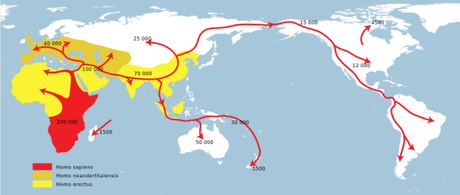
Modern humans evolved in Africa ~195,000 years ago. But - as you may have noticed - we didn't stay there. By ~100,000 years ago modern humans had began spreading around the world and getting into all sorts of trouble. However, brand new research reveals that this migration wasn't a one way street. The first analysis of ancient human DNA from Africa shows that there was also a significant movement of people into Africa!
This new ancient DNA comes from a 4,500 year old individual nicknamed "Mota". He was named after the Ethiopian cave where his remains were discovered. However, evidence of the into Africa migration wasn't found in Mota's genome. Rather, Mota acted as a "control" against which other DNA samples could be tested.
Even before Mota's analysis there was a lot of evidence of an into Africa migration. Most notably, many modern Africans have Neanderthal genes. Humans acquired these through interbreeding as they migrated out of Africa into Neanderthal territory. So their presence in African individuals shows that there was a migration back into Africa at some point; spreading the Neanderthal genes into the continent.
The issue is that we only have these modern genomes to examine. Genomes that are the end-product of all this in-and-out of Africa migration. Without the "starting" African genome, it's hard to pinpoint how large these migrations were, how much they changed and when they happened. It's like trying to solve an algebra equation when you only have the final result.
? + ? = Modern Africans.
That's where Mota comes in. He appears to represent one of those starting African genomes. He contains no evidence of Neanderthal genes or any of that other stuff that indicates a migration into Africa. Thus, by studying how different he was to modern Africans we can figure out how much those into Africa migrations changed.
And the Mota shows they changed a lot.
For starters, the fact that he's "untouched" at 4,500 years ago suggests that the big into Africa migration occurred more recently than that. Combined with existing data, he indicates that the backflow into Africa occurred around 3,000 years ago.
Mota also helped identify what genes had changed as a result of this migration (since they could see what had changed relative to Mota). This allowed researchers to track how far across Africa they had spread.
And it turns out they had spread an awful long way. Some of them even reached as far as South Africa. Whether this represented a migrating population travelling the length of the continent or simply genes being passed between existing African groups is unclear. But the point is that the into Africa backflow had some far reaching genetic consequences.
However, perhaps the most important thing Mota shows is just where these migrants came from. Since he helped isolate these migrating genes we can look back to see which non-Africa populations had them.
It turns out they belonged to some of the first farmers from the Fertile Crescent. We know that these farmers were spreading westwards into continental Europe around this time. So it also turns out that they were heading south, back into Africa. Clearly, farming had a much bigger effect on populations than we expected; enabling such a widespread flow of genes.
References
Boyd and Silk, 2012. How Humans Evolved
Llorente, M. G., Jones, E. R., Eriksson, A., Siska, V., Arthur, K. W., Arthur, J. W., ... & Manica, A. (2015). Ancient Ethiopian genome reveals extensive Eurasian admixture throughout the African continent. Science, aad2879.

